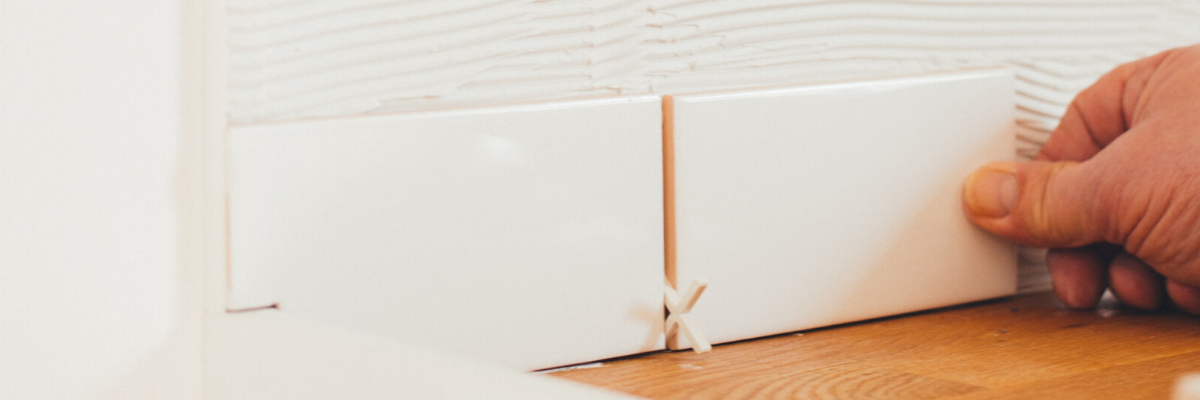When it comes to installing tile, it’s important that you follow a specific process to ensure that they stay put. Using the wrong grout type, or adhesive, can cost you hundreds of dollars down the line. Today we will walk you through choosing exactly the correct type of tile adhesive for your project, which materials are suitable for it, and common tricks to keep in mind.
The Types of Tile Adhesive Available
If you’re wondering what adhesive to use and where to use it, then the best place to start is knowing the different types available. There are two prominent adhesives that can be used when installing tile. The one you choose ultimately comes down to one of three considerations; if there’s moisture present in the tiled area, if there will be movement (i.e; flooring), or if there will be heat. Below we explore the main ones so you can find the best fit for your project.
Pre-Mixed Adhesive:
Tempting as it may be to use this pre-mixed adhesive in your design for convenience’s sake, it is not a fit for all applications. Pre-mixed adhesives come ready made in a tub and between the two adhesive options, it’s one of the most classics. This type of adhesive is quick to dry, and once tile gets stuck to it, it can be a bit of a pain to redesign placement. The latter works in the favor of some designs.
While it isn’t ideal for many situations, there are a few in which it reigns superior. The first is using it for ceramic tile. The second is when working against gravity, such as a kitchen backsplash. The reason for the latter is that the pre-mixed adhesive starts to hold the tile before it even sets, which reduces slippage.
As far as non-ideal circumstances, you should always avoid using pre-mixed adhesive in any area that moisture is present.
To work with mastic, spread the mortar quickly and twist the tiles into place. Working from the bottom up on walls, with a 2 x 4 to hold the bottom rows of tile in place, is recommended. If you need a hand with cutting tile, check out our guide here.
Thinset Mortar:
The second type of tile adhesive is thinset mortars. Unlike pre-mixed adhesive, thinset has a wide range of applications which makes it a pretty universal option. Though, it doesn’t come mixed in a handy way like its counterpart, it’s up to you to create the mixture to apply to tile.
Made from inorganic and materials mined from earth, thinset comes in either a modified or unmodified version.
The unmodified version is composted of cement, sand, and water retention agents; The modified version is composed of the same as listed prior with the addition of liquid latex polymers.
This type of adhesive is best used on floors, or areas where moisture is present, such as outdoors or the bathroom.
Know The Type of Tile Adhesive To Use
What tile adhesive to use on walls?
If you’re wondering what adhesive to use on walls, the answer varies depending on the space the wall resides in.
In the case of a kitchen backsplash or accent wall inside, then you can go ahead and enjoy the ever-convenient benefits of the pre-mixed adhesive.
Yet, if you’re placing tile on the floor or in any area that contains moisture (outdoors, in the bathroom), you will want to use thinset mortar.
What tile adhesive to use on wood (flooring)?
When it comes to a specific type of flooring, such as placing tile atop wood flooring, we suggest using thinset mortar. That said, it’s extremely important that before you do any tile work, you place a tile backing board on top of the wood or plywood. This will ensure an even surface level for application, warranting longevity.
What tile adhesive to use on cement?
When it comes to using tile adhesive on a cement surface, it is best to use thinset mortar.
If you’re placing tile adhesive over cement, then you should make sure that all dust/debris is first removed from it to ensure that the adhesive sticks. Additionally, you should make sure that you even the cement out so that it’s not sloping. A level surface is ideal for best results.
A Few Tips and Tricks To Keep Handy
When it comes to placing the adhesive, here are a few pointers that will help streamline the job:
Make sure to consult an expert when you’re deciding on adhesives for floor tiles. While there are two main categories, there are also subcategories that can have a specialty type that’s perfect for you.
Keep in mind that floors undergo heat, and high traffic. This should be important for choosing adhesive.
If you’re going to be placing on walls, in the kitchen. use pre-mixed adhesive. If you’re placing on the floor, seek a strong thinset mortar.
Use tile spacers when using thinset mortar to keep from slippage since it’s a slower-to-set material.
That about wraps up this know-how guide to tile adhesives. Feel free to comment below with your own tips or to ask questions! We’d love to hear from you.

